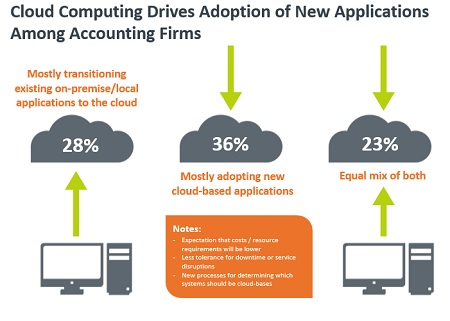The intersection of accounting and technology dates back to the earliest days of computing. For many businesses, spreadsheets such as VisiCalc, Lotus 1-2-3, and then Excel, were the killer apps of their day, elevating personal computers to must-have workplace tools.
Today, technology continues to be a critically important factor in the accounting world. According to CompTIA’s IT Opportunities in the Professional Services Vertical research, 8 in 10 accounting firms rate technology as an important force in reaching their business objectives. The data suggests this is more than just lip service, as 78 percent of accounting firms indicate they plan to increase their budgets for IT investments over the next 12 months.

With accounting firms employing 1.5 million workers nationwide, the sector has a large installed base of knowledge professionals heavily reliant on technology. This translates to billions of dollars in IT spending each year.
While some IT expenditures may be relatively straightforward, such as bookkeeping software, others may involve many more considerations and complexities. In this era of rapid and pervasive innovation, even the most tech savvy early adopter accounting firms may struggle to keep up with the vast array of options.
According to the research, slightly more than half of accounting firms report being well positioned with a technology vision and strategy, while the remaining segment report shortcomings in some area. As predominantly small businesses, few accounting firms have the depth of internal IT expertise to fully meet their most sophisticated technology needs.
 This serves as the underpinning of the IT solution provider value proposition to customer segments such as accounting firms. About 6 in 10 accounting firms worked with some type of IT solution provider, encompassing VARs, MSPs, break/fix, consulting, and related, during the past two years. Among those not working with an IT solution provider, the top reasons given include lack of need, cost, trouble finding a local provider, and uncertainty in initiating an engagement with an IT solution provider. These mentions should serve as a reminder to IT solution providers of the importance of following best practices in targeting market verticals. Consider:
This serves as the underpinning of the IT solution provider value proposition to customer segments such as accounting firms. About 6 in 10 accounting firms worked with some type of IT solution provider, encompassing VARs, MSPs, break/fix, consulting, and related, during the past two years. Among those not working with an IT solution provider, the top reasons given include lack of need, cost, trouble finding a local provider, and uncertainty in initiating an engagement with an IT solution provider. These mentions should serve as a reminder to IT solution providers of the importance of following best practices in targeting market verticals. Consider:
Focus, Focus, Focus on Business Objectives
The stronger the alignment between business objectives and technology solutions the better the chances of an initiative exceeding expectations. Otherwise, technology may be viewed as a cost center rather than an asset.
Connect the Dots
The days of siloed technology functioning in isolation are fading. Customers of all sizes need a technology roadmap showing how interconnectivity across devices, systems, and platforms come together. A net 59 percent of accounting firms benefited from cloud-driven innovation by adopting a new application, meaning the volume of intersection points with mobility, data, security, and more increased significantly. For IT solution providers, the question to be thinking about: how are your customers creating their technology roadmap? If these discussions are not taking place, or you are not involved in them, why not?
Offer Value All Along the Customer Technology Adoption Curve
Technology needs and execution strategies will vary significantly from early adopter to mainstream adopter to late adopter. It is often unrealistic to pursue only the high-end of the market, and there are often too few dollars to remain solely in the low-end. While it does require sufficient levels of expertise and business model agility, IT solution providers that can deliver the appropriate offering at the appropriate level are best situated to meet customer needs all along the customer technology adoption curve.
For more data and insights into how accounting firms, law firms, and marketing/PR firms are using, investing and managing technology, see the full research report here.
Additionally, for a quick one-page review of key points covering the accounting market vertical, see CompTIA’s Accounting Services Sector Cheat Sheet. Or, see the CompTIA Quick Start Guide to Entering a New Vertical Market.

 Add CompTIA to your favorite RSS reader
Add CompTIA to your favorite RSS reader
